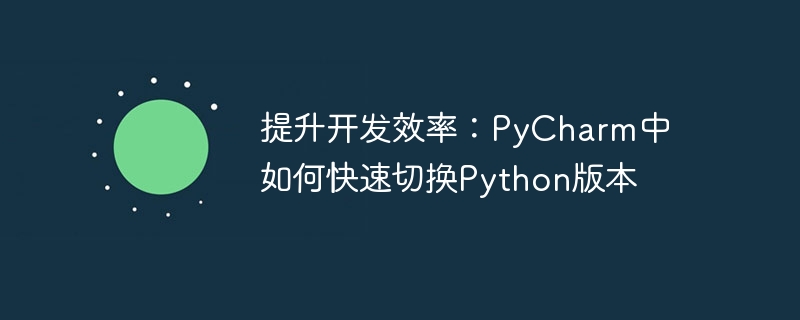Home >Backend Development >Python Tutorial >Improve development efficiency: How to quickly switch Python versions in PyCharm
Improve development efficiency: How to quickly switch Python versions in PyCharm
- WBOYWBOYWBOYWBOYWBOYWBOYWBOYWBOYWBOYWBOYWBOYWBOYWBOriginal
- 2024-01-05 15:58:251114browse

Improve development efficiency: How to quickly switch Python versions in PyCharm
In the Python development process, especially for developers who use different versions of Python for multiple projects. Say, you often need to quickly switch Python versions. PyCharm is a powerful Python integrated development environment that provides convenient functions to manage and switch Python versions. This article will introduce how to quickly switch Python versions in PyCharm, with specific code examples.
First, before using PyCharm, we need to ensure that the target Python version is installed. The corresponding version of Python can be downloaded and installed through the official website (https://www.python.org/downloads/). Here, we take Python3.7 and Python3.9 as examples.
Next, we need to open PyCharm and create a new Python project. During the project creation process, PyCharm will ask us to select a Python interpreter. We can choose the installed Python version or the system default version. In this example, we choose Python3.7.
After completing the project creation, we need to open the "Settings" window in PyCharm. The settings window can be opened by clicking "File" -> "Settings" in the menu.
In the settings window, we need to find the "Project Interpreter" option. Under this tab, we can see the Python interpreter version used by the current project. Click the "Settings" button (gear icon) in the upper right corner and select "Add...".
In the pop-up dialog box, we can see the Python version installed in the system. We can select the Python version we need to switch and click the "OK" button.
Next, we need to set the newly added Python version to the version used by the current project. In the settings window, click on the path of the Python interpreter used by the current project, select the newly added version, and click the "OK" button.
In this way, we have successfully switched the Python interpreter version in the project to the specified version. Next, we can verify the effect of version switching by running the Python code in the project.
Write a simple Python script in the project:
import sys print(sys.version)
After running the code, we can see the Python version used by the current project in the console output. If the output is consistent with the version we switched, the switch is successful.
In projects that use multiple Python versions, we may need to switch Python versions frequently. PyCharm provides a more intuitive way to switch versions. You can quickly select the required version by clicking the Python version number in the toolbar.
Summary: PyCharm’s quick Python version switching function provides us with convenience during the development process. Through simple settings, we can flexibly switch Python versions in different projects to improve development efficiency. This is a skill that Python developers must know.
The above is the detailed content of Improve development efficiency: How to quickly switch Python versions in PyCharm. For more information, please follow other related articles on the PHP Chinese website!
Related articles
See more- Solution to the problem of Pycharm outputting Chinese or printing garbled Chinese characters in python (picture)
- What is the difference between vscode and pycharm?
- Let's talk about how to switch Python versions at will
- How to implement the answering status synchronization and quick switching functions in online answering
- What is the shortcut key for quick switching between multiple screens in Win10?

